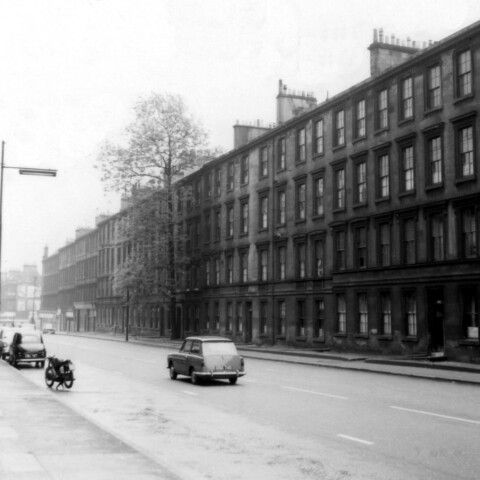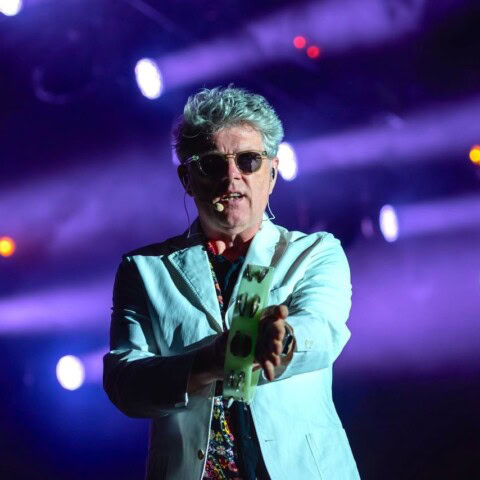GARY STEEL was there when Wellington synth-pop band The Body Electric’s ‘Pulsing’ took off in 1982. Here’s his take on the phenomenon.
 I’ve never quite been able to purge my mind of the image: the singer in New Zealand’s leading synth-pop band getting on down to the party grooves in the lounge of my Majoribanks St flat. Specifically, dancing and mouthing the words to ‘Pulsing’, the debut 12-inch single by his group, The Body Electric, released earlier just weeks before in late 1982.
I’ve never quite been able to purge my mind of the image: the singer in New Zealand’s leading synth-pop band getting on down to the party grooves in the lounge of my Majoribanks St flat. Specifically, dancing and mouthing the words to ‘Pulsing’, the debut 12-inch single by his group, The Body Electric, released earlier just weeks before in late 1982.
I lived on the top floor of a box-like circa-1900 house with my then-girlfriend and her rat-catching black cat Malinus. I was 23, publishing no-budget independent music magazines and house parties were the thing, because back then in Wellington there wasn’t much to do on a Saturday night except hunt the inner city suburbs for some party action.
Would you like to support our mission to bring intelligence, insight and great writing to entertainment journalism? Help to pay for the coffee that keeps our brains working and fingers typing just for you. Witchdoctor, entertainment for grownups. Your one-off (or monthly) $5 or $10 donation will support Witchdoctor.co.nz. and help us keep producing quality content. It’s really easy to donate, just click the ‘Become a supporter’ button below.
I would make up several cassette tape compilations to blast through my Dalek-like ESS Heil Air Motion Transformer loudspeakers – I’d given up on the turntable because, when people started pogoing, the needle would skip off the deck. The volume would inevitably creep up as the crowd became more dance-enthused and inebriated, until a little red circuit breaker on the speakers popped up and the room would fall silent for a minute or so while I reset “the Tegel timer”.
This particular night, The Body Electric’s amusing song came on soon after Garry walked in the door. It was one of those serendipitous moments. He may have been slightly embarrassed, but I’m sure that he was also proud to hear his track playlisted and the folks enjoying it as much as other contemporaneous songs like Grandmaster Flash’s ‘The Message’ or Soft Cell’s ‘Memorabilia’ along with post-punk tracks like Gang Of Four’s ‘To Hell With Poverty’.
 It was a somewhat musically and culturally odd moment in time. On the one hand, Wellington was hanging on to the punk/post-punk ethos with bands like Naked Spots Dance and the First Fifteen. On the other hand, in the past 18 months synth pop had blossomed internationally and other nascent music forms like hip-hop weren’t exactly waiting in the wings. There was also the politically neutral new romantic style espoused by the likes of Duran Duran and ABC, which for many provided relief from the rather dour, anti-society rhetoric of punk.
It was a somewhat musically and culturally odd moment in time. On the one hand, Wellington was hanging on to the punk/post-punk ethos with bands like Naked Spots Dance and the First Fifteen. On the other hand, in the past 18 months synth pop had blossomed internationally and other nascent music forms like hip-hop weren’t exactly waiting in the wings. There was also the politically neutral new romantic style espoused by the likes of Duran Duran and ABC, which for many provided relief from the rather dour, anti-society rhetoric of punk.
For me, it was all a wonderland to explore. I found that when playlisting for parties I could put Kraftwerk’s ‘Pocket Calculator’ next to The Gordons’ ‘Adults & Children’ next to Spandau Ballet’s ‘Chant Number 1’ next to The Birthday Party’s ‘Release The Bats’. Somehow, despite the contrasts, it worked. In fact, the punters would invariably go nuts.
I’d first met Garry when we were both pupils at Hamilton Boys’ High School. In 1977, we both opted for art classes but the art teacher had fallen ill, so Garry and I were sent over to Hamilton Girls’ High School. Terribly shy around girls at the time, I remember both of us being seated at the front of the class, which focused even more attention on us. It was all too humiliating, and I soon opted for a free library period instead of art class at Girls’ High. My memory of Garry was that he was kind of standoffish back then. An imposing physical presence, I’m still not sure if he somehow looked down on me or was simply, in his own way, just as shy and introverted as me. I had pegged him as a theatrical type but he never hung out with my gay friends whose whole lives revolved around drama.
 The following year I’d headed for the Wellington Polytech journalism course and washed up at The Evening Post newspaper in December that year, where I soon got the opportunity to do the only thing I ever really aspired to do: write about contemporary music. Then, late in 1979, with the help of Mike Aston from the sports desk, I started In Touch, a free rock magazine.
The following year I’d headed for the Wellington Polytech journalism course and washed up at The Evening Post newspaper in December that year, where I soon got the opportunity to do the only thing I ever really aspired to do: write about contemporary music. Then, late in 1979, with the help of Mike Aston from the sports desk, I started In Touch, a free rock magazine.
Midway through 1980, I was approached by Alan Jansson of punk group The Steroids to do some kind of sponsored editorial for the group’s first single, ‘Out Of Control/Mr Average’. Alan picked me up from my parents’ place in Island Bay where I’d been recovering from a severe bout of glandular fever, and I spent what could have been just a few hours or a whole lifetime with the group concocting a plan for world domination. I don’t remember any of the details because they got me so stoned I could barely remember my own name. Not only was I an utter novice but (as I learned later) their marijuana was especially and legendarily strong. I woke up the next day back at Island Bay. How did I even get home?
The Steroids made it to the front cover of In Touch, and in subsequent chats with Alan I recognised in him an astute and somewhat intense individual who was determined to make his mark. The Steroids were a solid, grunty and professional live act, but there was a sense that they’d slightly missed their chance. By the time their first (and only) single came out it sounded a little anachronistic – like something that would have come out in 1978 in the UK by a band like The Stranglers.
The next thing I knew Alan had discarded his guitar for a synthesiser and started The Body Electric with my former Hamilton Boys’ High School fellow sufferer Garry Smith on vocals and Andy Drey (from The Steroids) on bass – soon to be replaced by Wendy Calder. In 2022, synth-pop groups are everywhere, but in 1982, the explosion of electronic-oriented bands that had taken place in the UK over the previous few years just hadn’t happened in NZ. Gary Numan had toured in 1980 with his synth-enhanced alienated rock music, but just like NZ bands like Mi-Sex and Flight X7, this was more or less a typical rock group lineup with synths playing the role that Mellotrons played in early ‘70s pomp rock.
The revolution was really with the likes of former Ultravox man John Foxx, The Human League, Depeche Mode and many others who were benefitting from the first wave of affordable synths and drum machines. New Zealand also saw New Order touring in 1982, and for many their gigs were the first time we’d seen the new technology in all its glory in a live setting (and really loud). In 1983, New Order would release the synth-pop monster that for many would define the genre, ‘Blue Monday’.
But back in New Zealand, which still seemed as remote from the action as it was, there were precious few local examples of synth-pop. Auckland had Danse Macabre, whose moody sound was synth-drenched but still powered by mostly conventional rock elements. That’s why The Body Electric was such a blast of fresh air in 1982. There was nothing else like them locally, and their first single, ‘Pulsing’, appeared to take the piss out of the genre. Garry’s vocal was extremely theatrical, coming over like Vincent Price as he described the band’s music: “Rhythm and feedback noise… ELECTRODES!” You couldn’t help smiling.
The song was really nothing more than a tongue-in-cheek description of their music: “Listening to music created by machines/Silicon memories… Invent a clever chorus/synthesise a theme… Pulsing to metal music.” The music itself was quite basic by synth-pop standards, with a repetitive, layered synth sequence and basic, uh… pulsing beat and digital handclap. Kraftwerk had done the same thing a couple of years before with infinitely more subtlety on their genius Computer World album, but the German group’s schtick was extremely well defined and very Germanic.
‘Pulsing’ would prove to be both the group’s signature song and a rather large millstone around their necks. For reasons known only to themselves, they ended up releasing an additional 12-inch with remixes of the song, but for this listener, the novelty had long worn off. I saw them live a few times at venues like The Cricketers’ Arms pub, and while it was exciting to see new technology used in service to music, it always felt like the crowd were only there for “that song”, and as they became more polished and choreographed I found myself losing interest.
In 1983 The Body Electric finally released their debut (and as it turns out, their only) album, Presentation & Reality. I was a bit mean in my review of the album, writing that as much as I had enjoyed hearing it on my Sony Walkman I didn’t actually think it was very good. I noted the state-of-the-art production and sound quality, while ruing Garry Smith’s “pseudo-operatic” vocal style, which I felt had been borrowed from those new romantic crooners in England.
Subsequently, Jayrem label head and Chelsea record store owner James Moss told me that when Garry read my review he’d boiled over with rage and smashed a shop window in Manners Mall. Did this really happen? I’ll probably never know. Reading that review now I’m inclined to partially disagree with my verdict, and I was probably being overly harsh.
Presentation & Reality has been scrubbed up and reissued for Record Store day as a double album and a 12-inch EP with a few otherwise unavailable tracks. So, how does it scrub up nearly 40 years later? Pretty well, actually. The album is certainly light years from the rather crudely-recorded ‘Pulsing’, and parts of it have actually improved over time.
On reflection, my problem with Presentation & Reality was that I wanted something edgier, more experimental, when they were aiming at the pop market. Perhaps my issue with Garry’s vocals was a kind of cultural cringe. During the course of the album he does what character actors do and changes his voice according to the demands of the song, but most often, he croons. I guess I’m just fussy and it’s just not my thing.
What I tend to do now is concentrate on the electronic textures, which are remarkably sophisticated for a Wellington band newly hooked on synths recording in Wellington’s Marmalade studios. The drum machines and the layering of synthesisers is generally superb and imaginative, and then there’s the odd New Order-style bass line by Wendy Calder.
At various times the rhythms and sounds are reminiscent of Kraftwerk, Ultravox, Soft Cell, John Foxx, The Human League and other UK exponents of the synth-pop genre, but never to an overtly imitative degree. There are two rather enjoyable instrumentals but my favourite track is probably ‘Babies On Parade’, another tongue-in-cheek song with a melodic line straight out of some b-grade 1960s TV mystery anthology series.
The extra tracks on the EP are ‘Dash 1721’ (with Doctor Who-like synth-blips and another self-referential lyric about technology) and the very odd ‘Who Takes The Rap?’ (with its fake Jamaican accent and bizarre change of character). Were they trying out a new style just to see what worked?
 After the album came out there was a bit of touring but then things seemed to go quiet for The Body Electric. About a year later I chanced across Alan walking along Lambton Quay. His face was badly cut up and he was clearly not himself. He regaled me with a long story about how he’d had an accident and his car had overturned, leaving him hanging upside-down. He told me that a big chunk of flesh fell off his face and through the broken windscreen onto the ground, whereupon a dog had come along and eaten it. He’d spent months recuperating but had sustained serious injuries. The Body Electric was over.
After the album came out there was a bit of touring but then things seemed to go quiet for The Body Electric. About a year later I chanced across Alan walking along Lambton Quay. His face was badly cut up and he was clearly not himself. He regaled me with a long story about how he’d had an accident and his car had overturned, leaving him hanging upside-down. He told me that a big chunk of flesh fell off his face and through the broken windscreen onto the ground, whereupon a dog had come along and eaten it. He’d spent months recuperating but had sustained serious injuries. The Body Electric was over.
That was the last time I saw Alan until years later, by which time we’d both moved to Auckland. I had moved there to edit music magazine RTR Countdown and he’d started his own Uptown recording studio, where he eventually co-wrote and produced OMC’s internationally successful ‘How Bizarre’ and many other notable tracks.
Garry, who ended up as Concerts Manager for the NZSO, hasn’t spoken to me since my review of Presentation & Reality, and has turned down requests for an interview.
















